Notes: Contacts with Distant lands | Social Studies & Pedagogy Paper 2 for CTET & TET Exams - CTET & State TET PDF Download
After the decline of Mauryan Empire, several new kingdom arose in place of it. Many changes took place during this place, the changes were the spread of agriculture and the growth of new towns, craft production and increase in trade. Traders explored the land and sea route in search of new market for their products within and outside the sub-continent.
Introduction
- Did you ever imagine that more than 2,000 years ago, people from distant lands as far as Greece would come to India there were no airplanes, no trains and no motor vehicles? Well Alexander did, long journeys motivated by a desire to conquer foreign lands. Enthused with adventures form a big slice of man?s history. Let us see how these journeys and eventually the contacts with distant lands shaped and affect history.
- After the collapse of the Mauryan Empire, several small kingdoms came up. The most important development was the arrival of foreign tribal groups in India.
- The Indo- Greeks conquered much of northern India including parts of Uttar Pradesh. The most famous rules was Menander I. He converted to Buddhism. The Indo-Greeks issued coins, the first of which were minted under Menander I.

Indo-Greek coins have been found in large numbers in Himachal Pradesh. What can be inferred from this?
- The sakes were alien tribes who entered India by defeating the native kings and established a strong foundation of the Saka kingdom in India. Different branches ruled different parts of India. They were in continuous conflict with the Satavahanas.
- In the north. The last Mauryan ruler was murdered by his own commander-in- chief pushyamitra sunga. Who founded a new dynasty. This dynasty was followed by the kanavas. Finally the Gupta Empire was established here in the 4th century CE.
- The important kingdoms of the south were Cheras. Cholas and pandyas. The pallavas and Chalukyas ruled between 6th and 12th CE. We will be learning more about all these dynasties later in the chapters.
Kingdoms of the South
- India being a peninsula, the southern part has a long coastline which is beneficial for trade. Also. There are fertile river valleys like the Couvery river Valley. The rules who controlled these lands became very rich and established powerful kingdoms. Sangam literature mentions a Tamil word, muvender. Meaning three ruler These were the pandyas, Cholas and Cheras. These southern kindoms were in constant conflict for supremacy.
- The Pandyas occupied the southern extremity of India. Their capital was Madurai. The Pandya longs organised sangams in Madurai. The Pandya kingdom prospered in trade. The finest fisheries along the southern coast were under their control. The Chera kingdom occupied present day western Tamil Nadu and Kerala. The Cheras had an excellent navy, and carried on overseas trade with the Romans. Their main port was Muziris. The Cholas kingdom consisted of Tiruchi and Thanjavur regions in Tamil Nadu. Uraiyur was their capital and Cauverypattinam was an important port city.
- Another kingdom ruled by the Satavahana Dynasty rose to power in 200 BCE. They occupied a large part of central India known as dakshinapatha or the route to the south. Their capital city was Pratishthan. The most important ruler of this dynasty was Gautamiputra Satakarni. The Satavahanas were efficient rulers. Trade and commerce flourished under their rule. Bharuch was an important port. Ships from Iraq, Egypt, Persia and Arabia docked here. The Satavahanas were the first to issue coins with portraits of their rulers 7 embossed on them. The Satavahanas declined around the 3rd century CE.
History Reveals
The Satavahanas contributed to the spread of Buddhism. They built the famous Amaravati stupa. They also contributed to architecture. Some of the Ajanta Caves were built during their rule.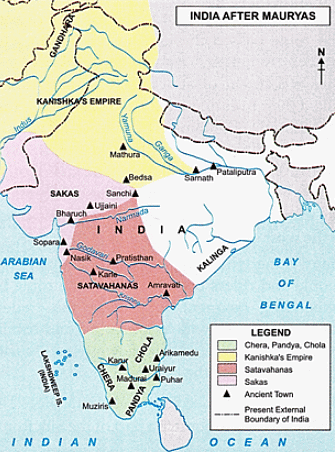 India after Mauryas
India after Mauryas
The Silk Route
Silk was a very popular fabric in the west. This shiny, smooth fabric was the most coveted and expensive textile in the west. Making it was a long and difficult process. Silk worms were bred, the shiny silk thread from the cocoons had to be taken, processed and then spun into thread. The silk thread was then woven into fabric. Though silk was made in China thousands of years ago, the process of making it was not disclosed to the outside world.
History Reveals
- According to the Chinese, silk was first accidentally discovered by a queen. A cocoon had fallen into her cup of tea. As she tried to pluck it out, she noticed a shiny thread unwinding from the cocoon.
- Traders took the fabric to the west and made huge profits. The route through which silk was taken to the west ramp to be known as the Silk Route. The 6,400 km long route linked the cities of the Middle East to the Chinese capital. The route passed through hostile terrain with difficult mountains and deserts. There was always a threat of attack by bandits. Traders risked their lives and led loaded caravans across deserts and mountains. The Silk Route became the first real link between the East and the West around 100 BCE. Apart from silk, many other goods like porcelain and Chinese inventions like gunpowder and paper etc. were also taken to the west.
- Many kingdoms lay along the route. The people and rulers tried to control the route by demanding payment for letting the traders pass through. They took taxes, gifts and tribute from the traders. In return, they offered security against robbers to the traders.
- The Silk Route passed through India also. The Kushanas tried to control a part of the Silk Route which passed through their kingdom in north and north-west India. A branch of the Silk Route went from central Asia to the mouth of the river Indus. From there the goods were shipped to the Roman Empire.
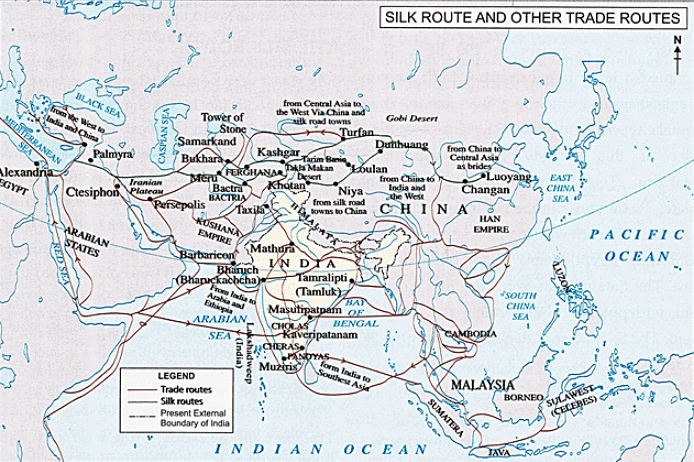 Silk Route and Other Trade Routes
Silk Route and Other Trade Routes - But, most importantly, the travellers and traders carried with them their culture, ideas and beliefs to distant lands. Buddhism spread to China through the Silk Route.
The Kushanas
The Kushana Empire covered northwest of India (which also includes Pakistan and modem day Afghanistan) and northern India. Kanishka was a great Kushana ruler. His capital was at Peshawar. He also constructed a new city called Kanishakapuram. He expanded his empire and defeated the Sakas. The kingdom was wealthy and prosperous and trade relations existed with Central Asia, Egypt and Rome. The Kushanas introduced the first gold coins in India.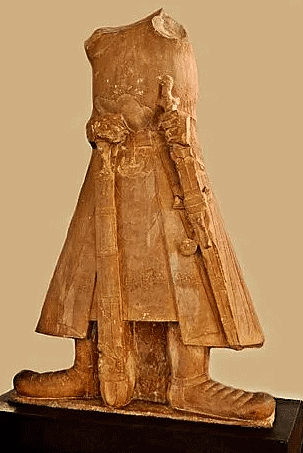 Headless Statue of Kanishka
Headless Statue of Kanishka
Spread of Buddhism
- Kanishka embraced Buddhism after his invasion of Pataliputra, where he came under the influence of Ashvaghosha, a Buddhist scholar. Impressed by his teachings, Kanishka devoted himself to the service of Buddhism. He organized a famous Buddhist council held in Kashmir. It was attended by scholars like Ashvaghosha and Vasumitra and important discussions took place. Buddhist scholars now began writing in Sanskrit. Ashvaghosha wrote Buddhacharita, a biography of the Buddha.
- It was during this time, that a new kind of Buddhism known as Mahayana Buddhism developed. Mahayana Buddhism had two different features. Now, Buddha came to be worshipped as a human figure and his idols were worshipped whereas earlier Buddha was always represented symbolically like a lotus or a Peepal tree. Secondly, the cult of bodhisattvas became widely prevalent. Bodhisattvas were people who had reached enlightenment. They could now teach people. The worship of bodhisattvas became very popular.
Mahayana Buddhism
- Kanishka took every step to spread Buddhism. He built many stupas and viharas. He propagated Buddhism to distant countries including Tibet, China, Burma, Japan, Korea and Central Asia.
- Buddhism also spread to other parts of India and countries like Sri Lanka, Thailand and South East Asia. Many monasteries were made in caves.
- The Statues of Buddha were made in Mathura and Taxila. Different styles were used in both the places. In Mathura, red sandstone has been used to make idols of the Buddha.
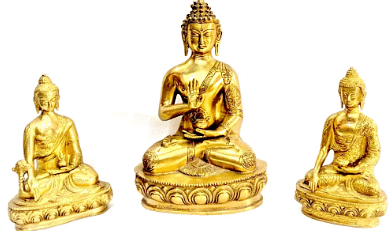 Different Style of Buddha Statue
Different Style of Buddha Statue
Foreign Pilgrims
- Foreign travellers who visited India also contributed to the spread of Buddhism. Many pilgrims also travelled along the Silk Route to India.
- Fa-Hein was a Chinese pilgrim who came to India in 399 CE during the reign of Chandragupta II. He came in search of the complete copies of Vinaya Pitaka. He stayed here for 16 years, travelling extensively. He visited all the places associated with the life of the Buddha and held discussions with Buddhist scholars. For three years he stayed in the imperial city of Pataliputra, where he learnt Sanskrit. When he went back, he took with him books and images sacred to Buddhism. On his way back, Fa-Hein sailed from Bengal. Unfortunately, there was a storm and he had to throw away all his belongings but managed to save the books and statues of the Buddha that he had collected. These he treasured more than anything else. He reached Java and later from here he boarded a ship back to China.
How did the Silk Route help in the spread of Buddhism?
- He recorded his travels in Travels of Fa-Hein'. It is a valuable resource to the researchers studying the Buddhist religion and ancient history of the land.
- Hieun Tsang came in the 7th century CE during Harsha's rule. He collected authentic Buddhist scriptures. He witnessed the Buddhist assemblies at Prayag and Kanauj. He returned to China after staying in India for nearly 15 years and ' carried back a large number of Buddha images in gold, silver and sandalwood and above all, 657 volumes of valuable manuscripts, carried by twenty horses of his escort party. Tragically, many of the scriptures were lost when the boat he was using to cross the River Indus capsized. He recorded his experiences in Si-yu-ki. Therefore, he has been described as the "Prince of Pilgrims." In China, he devoted himself to the translation of the texts which he had brought back.
 Hiuen Tsang
Hiuen Tsang
Nalanda University
- Nalanda was a great center of Buddhist learning in ancient times. A large number of Buddhist students from different parts of the world thronged the Nalanda University to study Buddhism. Lord Mahavira and Lord Buddha visited Nalanda quite frequently in the 6th century BC. There were thousands of students and teachers. The curricula of the university offered study of abstract knowledge like Philosophy, religion. Buddhism and scientific thoughts in astronomy, mathematics, anatomy etc.
- The Nalanda University received patronage from the great emperor, Harshavardhana and the Pala rulers. The famous Chinese pilgrims, Hieun Tsang and Fa Hein were among the distinguished students of the Nalanda University. Hieun Tsang was impressed by the passion of the Indian people for learning.
The Beginning of Bhakti
- During this period, the bhakti cult was gradually becoming popular. The worship of certain gods like Vishnu, Shiva and Goddess Durga became important. They were worshipped with love and bhakti (meaning devotion). The idea of bhakti was first referred to in the Bhagwat Gita. In the discourse to Arjuna, Lord Krishna tells him to be devoted to him only as only he can guide Arjuna.
- People from any caste, gender, rich or poor could worship any deity with bhakti. Those who believed in bhakti or devotion to one god did not believe in performing rituals and sacrifices. We will learn more about the bhakti cult in Class 7.
Around The World
- The people of the great Roman Empire were in pagans? before the advent of Christianity. The state granted freedom to follow any religion. They used to worship the Greek deities. But around 30CE a new religious movement began in the distant following the teaching of Jesus Christ?s Gradually it spread throughout the Mediterranean. For the next 300 years following Christians as the threat and doubted their loyalty towards Rome. Christians did not take part in Roman politics and law since they involved pagan beliefs and traditions.
- As a result, Roman officials had Christians killed sporadically converted to CE, the Roman General Constantine converted to Christianity and became the emperor of the Roman state in the same year. He allowed churches to be built and protected the Christians. Emperor Theodosius the Great later declared Christianity had become as the state religion and outlawed all other religious By 392 CE, Christianity had become a powerful force and it was practiced throughout the empire.
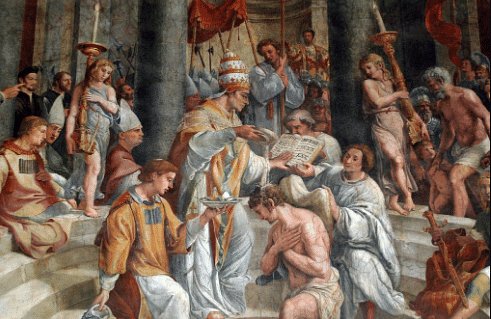 The Baptism of Constantine, as imagined by students of Raphael.
The Baptism of Constantine, as imagined by students of Raphael.
Summary
- After the collapse of the Mauryan Empire, several small kingdoms came up. The most important development was the arrival of foreign tribal groups in India.
- The important kingdoms of the south were Cheras, Cholas and Pandyas. These three southern kingdoms were in constant conflict for supremacy.
- Another kingdom ruled by the Satavahana Dynasty rose to power in 200 BCE. They occupied a large part of central India known as dakshinapatha.
- The route through which silk was taken to the west came to be known as the Silk Route.
- Kanishka was a great Kushana ruler. He took every step to spread Buddhism. He built many stupas and viharas. He propagated Buddhism to distant countries.
- Many pilgrims also travelled along the Silk Route to India.
- Fa-Hein was a Chinese pilgrim who came to India in 399 CE in search of the complete copies of Vinaya Pitaka. He recorded his travels in ?Travels of Fa-Hein?.
- Hieun Tsang came in the 7th century CE and collected authentic Buddhist scriptures. He witnessed the Buddhist assemblies at Prayag and Kanauj. He recorded his experiences in Si-yu-ki.
- During this period, the bhakti cult was gradually becoming popular.
|
75 videos|320 docs|78 tests
|
FAQs on Notes: Contacts with Distant lands - Social Studies & Pedagogy Paper 2 for CTET & TET Exams - CTET & State TET
| 1. What is the significance of contacts with distant lands in history? |  |
| 2. How did contacts with distant lands contribute to the development of trade and commerce? |  |
| 3. How did contacts with distant lands impact cultural exchange and societal development? |  |
| 4. What were some of the key explorations and expeditions that resulted from contacts with distant lands? |  |
| 5. How did contacts with distant lands influence technological advancements and scientific discoveries? |  |
















